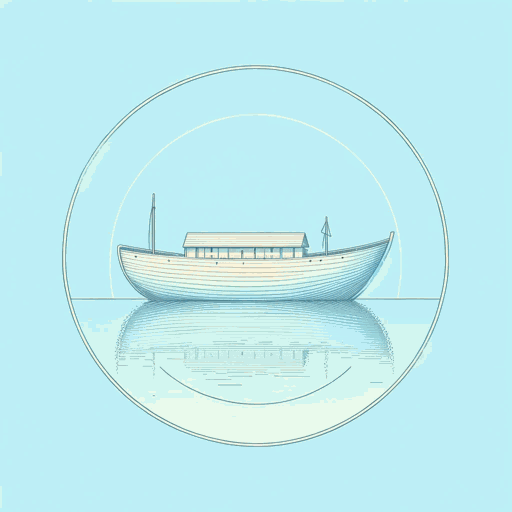51 pages • 1 hour read
Thornton WilderThe Skin of Our Teeth
Fiction | Play | Adult | Published in 1942A modern alternative to SparkNotes and CliffsNotes, SuperSummary offers high-quality Study Guides with detailed chapter summaries and analysis of major themes, characters, and more.
Summary and Study Guide
Overview
Thornton Wilder’s dramatic masterpiece, The Skin of Our Teeth, opened on Broadway in November of 1942, less than a year after the United States entered World War II. On the heels of the Great Depression (1929-1939), the war meant more sacrifice and hardship for the average American family, and another era of fear, loss, and anxiety about the future of humanity. The play is a satirical allegory for the human race’s seemingly indomitable will to survive, offering a message of hope in human resilience. The Antrobus family (a combination of anthropos, or “human” in Greek, and omnibus, or “all” in Latin) simultaneously represent the archetypal American nuclear family, the prototypical family for all of humankind, and Adam and Eve, the first family of the Judeo-Christian mythology. The family of four, always accompanied by their sometimes-maid, sometimes-husband’s mistress, is far from perfect. They contain all the innovations and forward motion of humanity and all the faults and weaknesses, yet they survive through three human extinction events (an ice age, a great flood, and a catastrophic war) by the skin of their teeth.
Structurally and aesthetically, Wilder integrates elements from modernist theater movements that developed in early-20th-century Europe to defy traditionalist artistic conventions that seemed insufficient to represent a world in which human consciousness had shifted after the unprecedented horrors of World War I. For instance, Wilder uses conventions of surrealism, a movement that focused on representing the unconscious mind, by juxtaposing the surprising and the illogical, often to humorous effect. Wilder also employs the tactics of Bertolt Brecht and epic theater by constantly reminding audiences that they are watching a play. In The Skin of Our Teeth, this has the effect of including the audience in the narrative. Wilder was interested in depicting events that are not only relatable but are the types of occurrences that humans experience over and over: the repetition of loyalty and commitment in a marriage that continues despite a betrayal; a parent’s protection and love for a child who has done something terrible; or making difficult decisions and sacrifices for the sake of one’s family. One constant that occurs endlessly is the continuance of humanity despite impossible odds.
The play explores these constants by breaking common conventions, including the use of a cyclical plot structure, which means that the play ends by repeating the beginning, suggesting that it will continue to repeat itself rather than reaching a conclusion. Wilder is one of the most celebrated American playwrights of the 20th century. He won his third Pulitzer Prize for The Skin of Our Teeth in 1943, having won the Pulitzer Prize for the Novel in 1927 for The Bridge of San Luis Rey and the Pulitzer Prize for Drama in 1938 for Our Town, which made him the only person to ever win the prize for both fiction and drama. Our Town remains Wilder’s most well-known and popularly produced play, using some approaches that Wilder would build upon in The Skin of Our Teeth, such as metatheatricality, or the convention of acknowledging within the text that the play is a performance and the characters are played by actors, and the use of personal domestic relationships to represent larger and more universal ideals. The original Broadway production of The Skin of Our Teeth was directed by Elia Kazan, who was possibly the most famous and honored theater and film director of the era, and starred Tallulah Bankhead, Frederic March, Montgomery Clift, and Florence Eldridge.
This study guide references the 2003 Perennial Classics edition of The Skin of Our Teeth.
Plot Summary
In Act I, Wilder introduces the audience to George Antrobus and his wife Maggie, their children Henry and Gladys, and their attractive maid Lily Sabina Fairweather in a middle-class New Jersey town called Excelsior. George is an inventor and carries around his creations, which include the alphabet, the wheel, and the lever. The dialogue reveals that there was once another son whom Henry killed. This allusion implies Henry is Cain, the son of Adam in the Bible, and makes clear to the audience that George is the allegorical representation of Adam. In a song George sings to his wife, Mrs. Antrobus is referred to as Eve. There are living dinosaurs and mammoths in the backyard. In some performances of the play, these are displayed as piñatas or as figures reminiscent to the monsters of the children’s book Where the Wild Things Are.
During this first act, a southern-moving block of ice is making its way from Canada, marking the beginning of an imminent ice age. This sets the stage for stress and brings the arrival of refugees needing safety, the likes of which are historical figures, such as Plato, Moses, and Homer.
Act II opens to the setting of Atlantic City’s boardwalk where George is being elected “President of the Ancient and Honorable Order of Mammals, Subdivision Human.” The actress playing the maid of Sabina is now known as Lily Sabina, and George selects her to be Miss Atlantic City. It is made clear that Lily Sabina is an allusion to the myth of Lilith, a somewhat dangerous woman according to Jewish folklore, and she tries to seduce and steal him from Mrs. Antrobus. However, a big storm is brewing, and when many animals come to see George deliver a speech, he realizes there is a great flood coming. He and the rest of the Antrobus family encourage the animals to enter an ark-like ship, two by two.
The final act of the play sees the family returning together after a long catastrophic war. With the discovery of the destruction of their home, the Antrobus ponder whether it is pointless to rebuild their lives once again after yet another disaster. The play ends with the maid Sabina cleaning and repeating her lines from the opening scenes of Act I, symbolizing the circular nature of time and the ability of the human race to begin again.
Related Titles
By Thornton Wilder
Featured Collections
Allegories of Modern Life
View Collection
Dramatic Plays
View Collection
Family
View Collection
Good & Evil
View Collection
Hate & Anger
View Collection
Pride Month Reads
View Collection
Pulitzer Prize Fiction Awardees &...
View Collection
The Future
View Collection
The Past
View Collection
War
View Collection
World War II
View Collection



